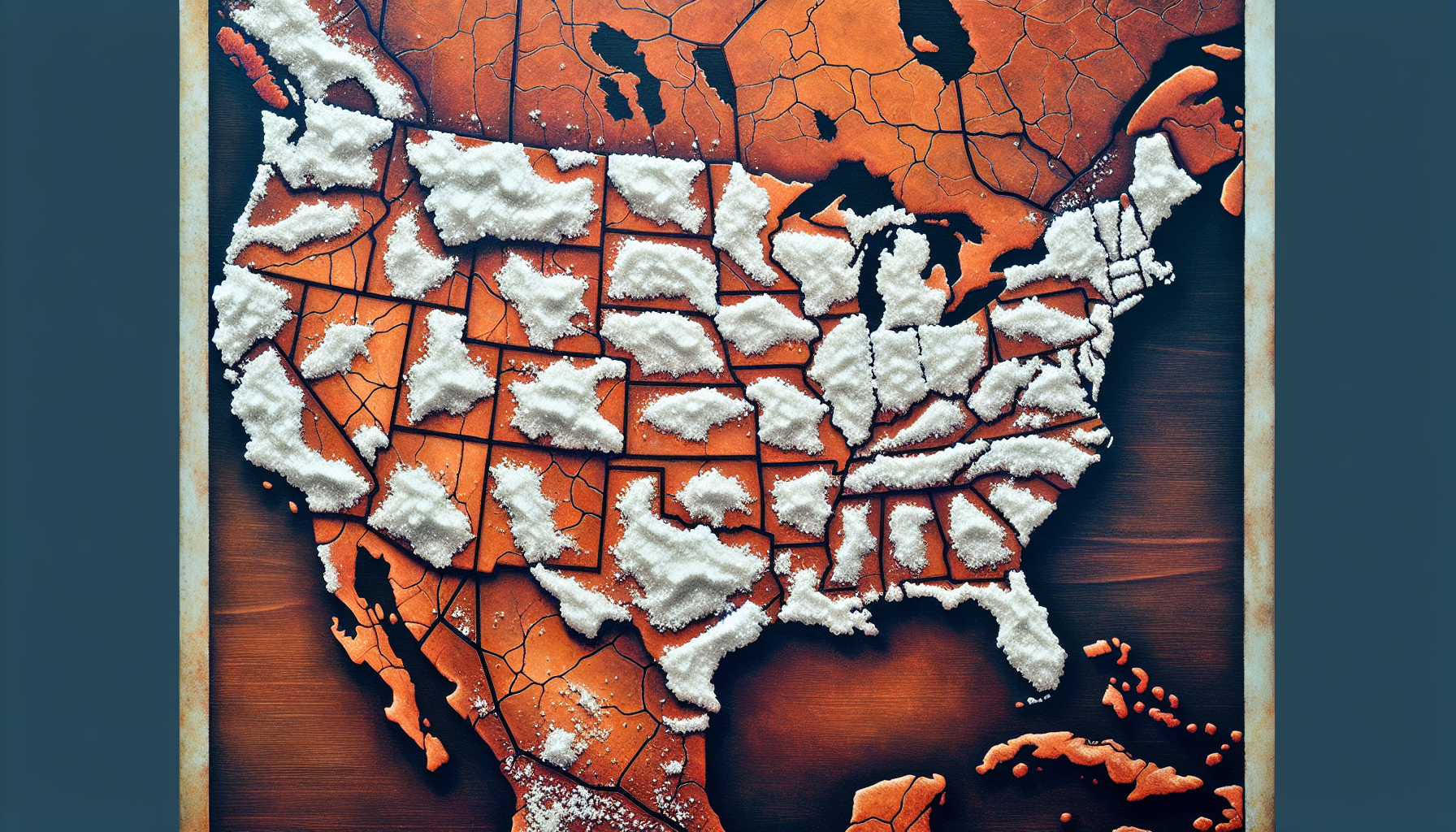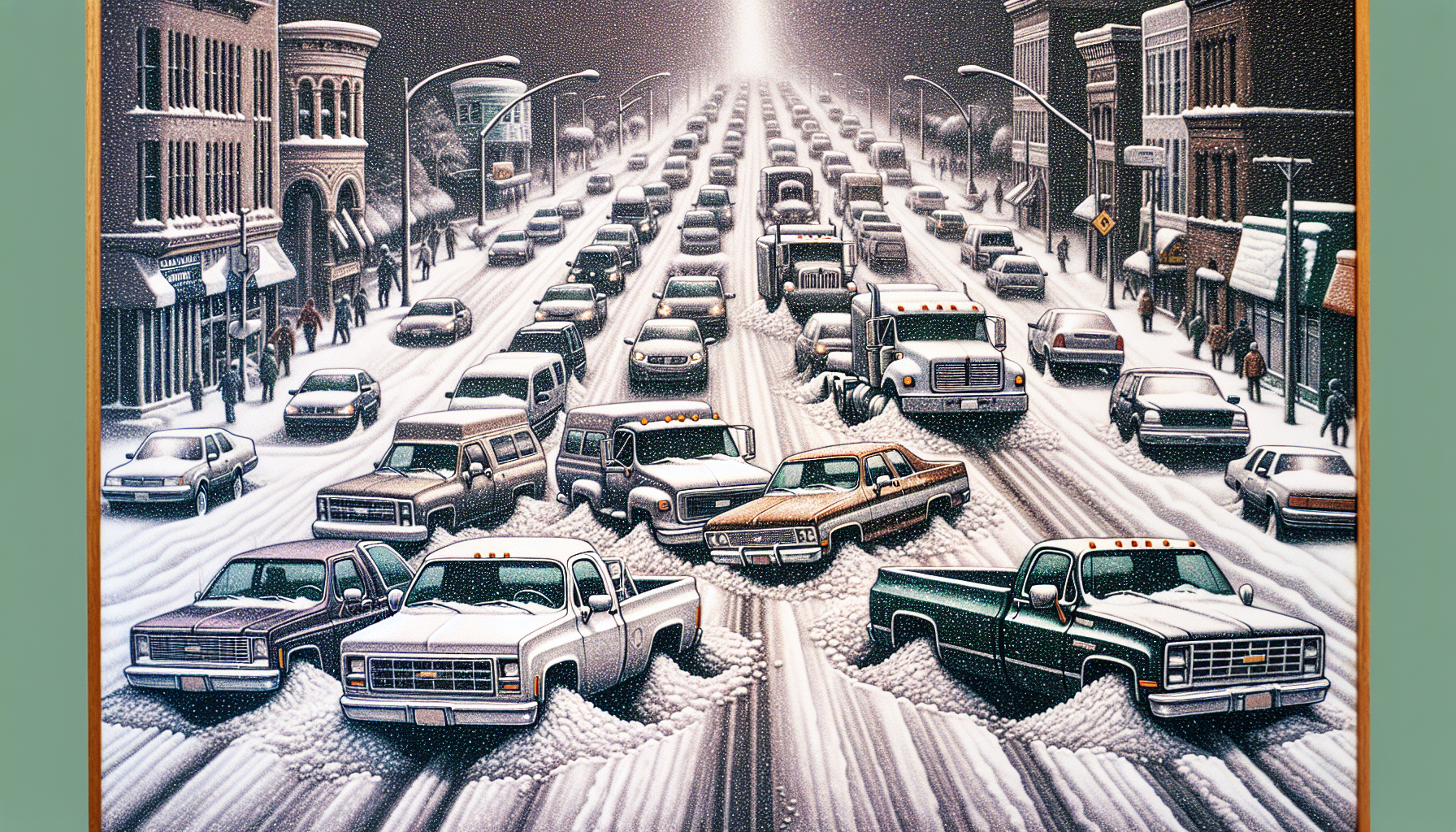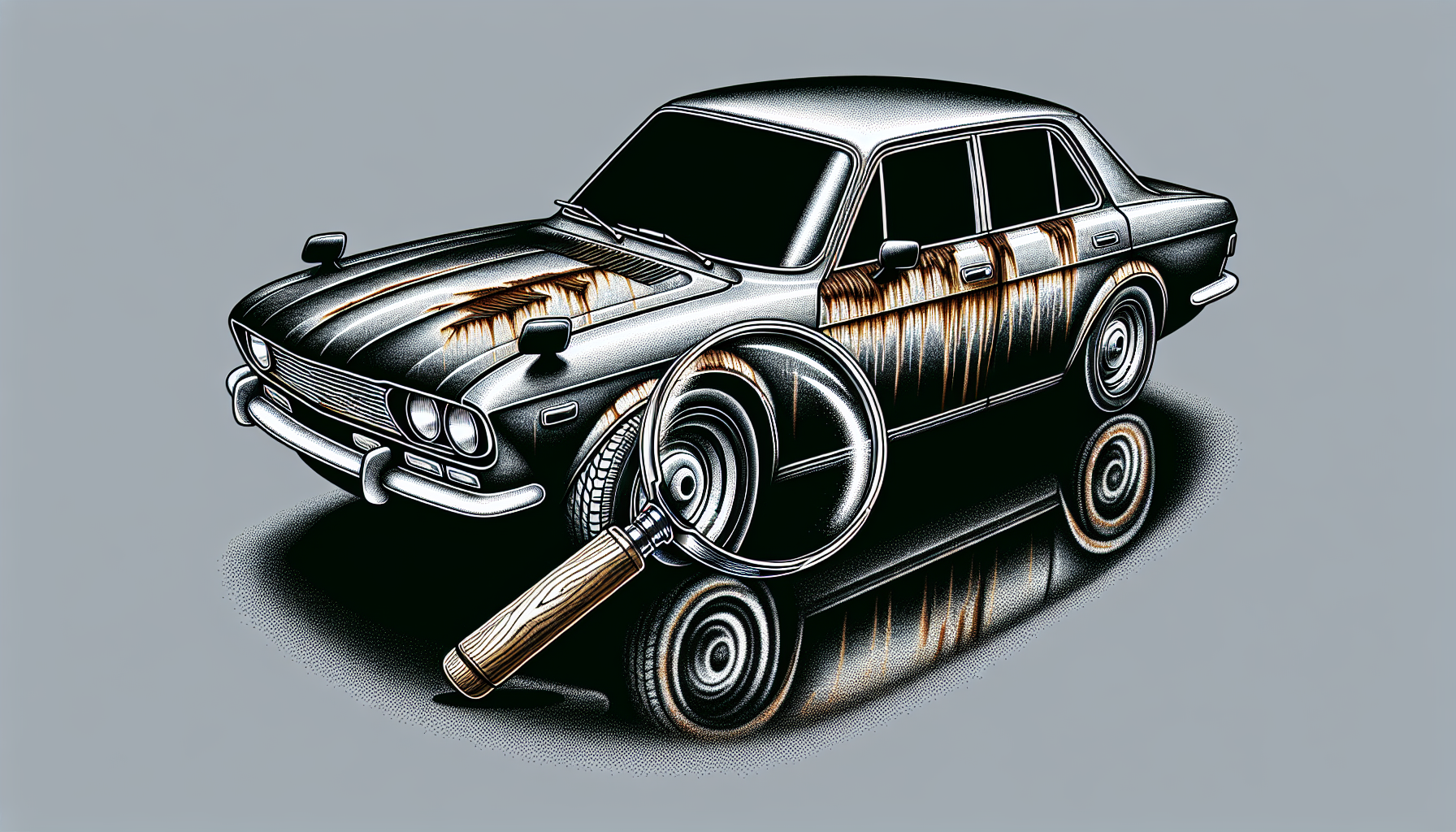Seeking what states are the worst for car rust? States within the infamous ‘Salt Belt’—mainly in the Northeast and Midwest—and coastal areas with salty sea air top the list. Our guide identifies these high-risk environments and dives into the dangers of car rust, so you can take necessary measures to safeguard your vehicle.
Key Takeaways
- The Salt Belt, primarily in the Northeastern United States, and other high-risk areas like coastal and agricultural zones, expose vehicles to harsh conditions that significantly accelerate rust, impacting vehicle safety and integrity.
- Vigilance in maintenance with regular inspections, thorough washing, rust-proofing treatments, and the use of protective coatings can prevent or minimize rust damage in vehicles, particularly in high-risk states.
- A comprehensive approach including professional inspections, vehicle history reports, and considering rust repair costs is essential when purchasing used vehicles or dealing with existing rust to maintain safety and vehicle value.
Mapping the Salt Belt: Identifying High-Risk Rust States

If you’ve ever watched a winter storm descend upon the Northeast and Midwest of the United States, you’ll know it’s a sight to behold. Yet, beneath the serene blanket of snow lies a silent assailant. This region, known as the Salt Belt, is characterized by its harsh winters, which necessitate heavy road salt usage for deicing. The Salt Belt is an invisible band of corrosion, a ribbon of rust that wraps itself around states where road salt is extensively used to combat icy conditions.
Areas within the Salt Belt region, primarily in the Northeastern United States, pose the highest risk for vehicle rust due to the frequent use of road salt. The constant battle against the elements here means that cars face a perpetual onslaught of this corrosive compound, accelerating the onset of rust.
The Science of Salt: Why It’s a Car’s Enemy
Understanding the formation of rust is a complex process. Salt is used on roads to lower the freezing point of snow and ice, providing better traction for vehicles. However, this creates a more corrosive environment that promotes rust on vehicles. The mixture of road salt and water from snow or sleet creates a corrosive saltwater solution that accelerates the rusting of metal surfaces on cars.
Road salt, including rock salt, has the ability to decrease water’s freezing point, enabling electrochemical corrosion reactions in cold temperatures and thus exacerbating vehicle rust. In this hostile environment, chloride ions from dissolved road salt infiltrate the protective oxide layers that form on metal car components, leading to the initiation of corrosion. Hence, despite ensuring safety on icy roads, too much salt in the form of road salt poses a significant threat to our vehicles’ lifespan.
Beyond the Belt: Other High-Risk Rust States
Although the Salt Belt is the rust crisis’s epicenter, it doesn’t limit its reach. States outside the Salt Belt, such as Kentucky and Nebraska, also encounter conditions that foster high car rust risk. Environmental conditions conducive to vehicle corrosion, ranging from high humidity to frequent rainfall, can lead to accelerated rusting even in states not traditionally associated with heavy road salt usage.
Within any given state, the risk of car rust can vary depending on local climate and environmental factors. For example, coastal regions might experience rust issues due to the presence of salty sea air, while farming areas could see accelerated rusting due to exposure to agricultural chemicals. It appears that the struggle against rust extends beyond the Salt Belt, affecting the entire nation.
Navigating Through New England: Rust’s Playground

Rust thrives in the picturesque landscapes of New England. Especially during winter, there is a notable increase in corrosion and rust under vehicles due to road salt. Recent winters have seen the introduction of a new type of snow salt in Massachusetts that has been causing severe corrosion in vehicles.
Parts that are particularly susceptible to damage from corrosion include:
- Control arms
- Exhaust pipes
- Entire brake systems
- Sub-frames
The cold northern winds and icy conditions may give New England its picturesque winters, but they also create a perfect storm for rust.
Coastal Concerns: The Role of Sea Spray in Vehicle Corrosion
Yet, winter conditions aren’t the only threat. New England’s coastal environment is particularly harsh on vehicles, including new cars, due to the presence of salt air combined with ice-melting road chemicals. The proximity to ocean salt exposes vehicles to conditions that accelerate metal corrosion, with the salty sea mist acting as a covertly corrosive element for cars, particularly those that are closer to the beach or that frequent coastal areas.
Vehicles located within 10 miles of the coast are especially susceptible to rust as they are regularly exposed to salty sea spray. So, if you live in a coastal town or regularly enjoy beach trips, be aware that your car is at a higher risk of rusting, and take appropriate preventive measures.
The Midwest Meltdown: Where Vehicles Face Rust Battles

In the Midwest, vehicles confront unique challenges. Heavy snowfall in the region leads to the use of salt and sand mixtures on roads for vehicle safety. While these mixtures mitigate icy conditions and increase road safety, they come at the cost of increasing the likelihood of vehicle rust.
Frequent freeze-thaw cycles and the application of road salt and sand contribute to undercarriage damage and accelerated rusting in Midwest vehicles. This region’s reliance on chemical deicers places vehicles at a higher risk of corrosion, necessitating regular maintenance to mitigate rust.
Farm Country Fallout: Agricultural Chemicals and Rust
In the farming areas of the Midwest, agricultural chemicals significantly contribute to the acceleration of the rusting process on vehicles. Fertilizers, pesticides, and manure, which are common on farms, are chemicals that create a high-risk environment for vehicle rusting.
The combination of moisture present in the Midwest and exposure to farming chemicals intensifies the corrosion and rusting of vehicles. As such, car owners in agricultural regions should take proactive measures to protect their vehicles from rust, such as regular washing to remove chemical residues.
The Hidden Hazards: How Rust Compromises Vehicle Safety

Rust is more than just a cosmetic problem. It can severely compromise the structural integrity of a vehicle, such as the chassis and engine mounts, which lowers stability and diminishes the vehicle’s ability to protect its occupants during accidents. The weakening of a vehicle’s body due to rust can lead to more severe damage in the event of impact, heightening the risk of injury.
Rust damage can disrupt normal vehicle operations by making it difficult to open or close doors, hood, or trunk, signaling potentially hazardous underlying structural damage. Moreover, corroded elements may cause critical safety features to malfunction, undermining the vehicle’s designed response in emergency situations. Visible signs, such as bends or cracks in the vehicle structure, can indicate serious deterioration from rust, alerting owners to safety-compromised conditions.
Underneath It All: Spotting Early Signs of Rust
Successful vigilance against rust starts with discerning what to search for. Staining on the car’s surface can be an early indicator of rust development. Rust may also begin inside a panel or part and expand outwards, making it crucial to inspect for more than just surface rust. Areas less visible like fenders, rocker panels, and doors should be inspected and treated with rust-proofing spray to prevent rust from forming in places prone to moisture accumulation.
Sunlight can exacerbate the damage to car paint in combination with salt spray by causing pores to expand, absorbing more salt and resulting in increased corrosion. Damage from exposure to ocean particles often doesn’t become visible until five to seven years after the exposure. This underscores the importance of proactive measures in rust prevention.
Pre-Purchase Vigilance: Evaluating Used Cars for Rust Damage
Inspecting for rust damage is crucial when purchasing a used car. This includes looking at the exterior for bubbling paint, examining the vehicle’s body for pitting characterized by small holes, and checking the underside of the car, including frame rails, wheel wells, exhaust, and suspension. Other areas to check for rust during a visual inspection include under the trunk carpeting, doors, and areas around the windshield and rear glass.
During a test drive, take note of:
- Unusual squeaks and rattles
- Signs of previous damage such as the car pulling to one side
- Any other performance issues that may indicate hidden rust damage
However, a visual inspection and vehicle history report are not enough. A mechanic’s detailed inspection is critical for uncovering rust damage not immediately apparent, ensuring a more thorough evaluation of the used car’s condition.
The Importance of a Vehicle History Report
When buying a used car, considering a new car as an alternative might not be a bad idea. However, a vehicle history report serves as a vital instrument for used car purchases, whether from a car dealer, private sellers, or a private owner. It’s important to remember that these reports may not record all incidents, including some maintenance records, which can impact a used car’s value. Minor accidents, repairs done by independent mechanics, or transactions outside the standard titling process at a new car dealer might not be included.
Thus, while a vehicle history report can provide valuable information about a car’s past, it doesn’t replace a thorough inspection by a trained mechanic. The report can give you an idea of the car’s history, but it’s the mechanic who can identify current issues and potential future problems, including hidden rust damage.
DIY Defense: Protecting Your Car from Rust in High-Risk States

Despite residing in high-risk states, there exist methods to shield your car from rust’s destructive effects. Regularly washing the undercarriage of the car, especially after snowstorms, can eliminate salt and other deposits that lead to rust. Wax-based sealants and rust-inhibiting sprays can be applied under the car and to other parts like brake lines and frames to create a barrier against corrosion.
Safety gear such as a respirator and gloves should be worn when spraying rust-proofing products, and special care must be taken to avoid sensitive areas of the car like plastic and rubber components. In addition, promptly sanding small rust spots away, performing regular vehicle inspections, and doing immediate touch-ups on scratches or chips are essential practices to prevent rust.
When Rust Strikes: Seeking Professional Help and Replacement Parts
Nevertheless, if rust results in structural damage or breaches the metal, professional intervention becomes essential. Simple surface treatments are no longer effective in such cases, and significant parts of the car’s body may be deteriorating due to rust. Quality replacement body panels and parts are crucial for restoring the vehicle’s appearance and maintaining its value, and should be sourced from trusted brands to ensure durability and a proper fit that matches the original factory specifications.
If rust affects essential components such as the suspension system, transmission system, or drivetrain, a professional assessment is needed to determine the extent of the damage and conduct the necessary repairs. Neglecting minor rust spots can lead to greater expenses down the line, including significant repairs and towing bills.
Financing the Fight Against Rust: Costs and Considerations
Rust bears financial consequences as well. It can significantly reduce a car’s resale value, with minor surface rust potentially devaluing a car by 10% and extensive structural rust leading to a minimum loss of 20% of the car’s value. To prevent rust, undercoating a vehicle costs approximately $399 to $500, while rust-proofing can cost between $525 and $725, with these costs varying based on the size of the vehicle.
Repair costs for rust can vary widely, with minor surface issues costing roughly £100 to £300, more significant repairs ranging from £400 to £1,000, and extensive structural rust repair starting at £1,000. Bypassing the purchase of a car with rust issues is advantageous as rust can lead to considerably higher ongoing maintenance and repair costs.
Summary
In summary, understanding the risk of vehicle rust and taking appropriate preventive measures is critical. From the Salt Belt to coastal New England to the farming areas of the Midwest, environmental conditions and road salt usage can significantly increase the risk of vehicle rust. Regular inspections, prompt treatment of rust spots, and professional maintenance can help prolong the life of your vehicle and ensure its safety. Remember, rust is more than just an eyesore – it’s a safety hazard that can compromise the structural integrity of your vehicle and significantly reduce its value. So, stay alert, be proactive, and let’s win the war against rust!
Frequently Asked Questions
What not to say when buying a used car?
Avoid saying “I love this car!” or “I’ve been looking all over for this color.” when buying a used car. These statements can weaken your negotiation position and potentially result in a less favorable deal.
Where in the US do cars rust the least?
Cars rust the least in California and the Southwest region, including states like Arizona and New Mexico, due to their mild winters and warm summers, which help prevent rust and corrosion.
What is the Salt Belt?
The Salt Belt refers to states in the Northeast and Midwest of the United States that experience harsh winters, leading to increased vehicle rust due to heavy road salt usage.
Why does road salt contribute to vehicle rusting?
Road salt contributes to vehicle rusting because it creates a corrosive saltwater solution that accelerates the rusting of metal surfaces on cars by lowering the freezing point of snow and ice and allowing chloride ions to infiltrate protective oxide layers on metal car components.
What parts of a car are most susceptible to rust?
The most susceptible parts of a car to rust are the fenders, rocker panels, doors, exhaust system, frame rails, wheel wells, suspension, and under the vehicle. Be sure to inspect these areas regularly for signs of rust.
For more information, visit https://www.carmula.com/





 Who We Are
Who We Are Coverage Area
Coverage Area Donate
Donate